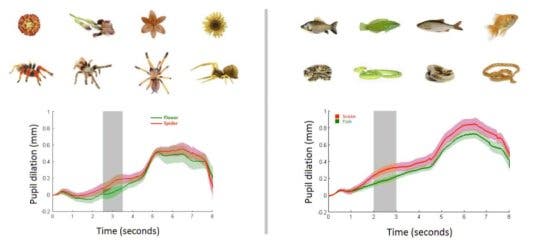Many people are disgusted by or scared of spiders and snakes. Although homes in industrialized countries do contain house spiders, most of these are completely harmless and provide pesticide-free insect control. Still, without having much negative contact with them, spiders and snakes give many people the shivers. The reason could be deeply embedded within us.
One to five percent of people who live in developed countries have a true phobia or spiders or snakes and a third of children strongly dislike them. It has been unclear so far if this has been a learned fear, like Indiana Jones’ fear of snakes which arose from falling into a crate of them while escaping a pursuer. The other option is that this aversion to snakes and spider is built-in to humans and present from birth.

Previous studies have not been able to able to answer this question of whether a fear of spiders and snakes is innate from birth. They have been conducted with older children and adults, making it confusing to tell if the behaviour was learnt or not. Other studies tested if children could pick out spiders and snakes faster than harmless objects. What needed to be tested was if infants show fear in response to spiders and snakes.
Not to fear, infants weren’t dropped into a snake pit or shown scary spiders. Scientists from the Max Planck Institute for Human Cognitive and Brain Sciences in Leipzig and Uppsala University showed six-month-old infants pictures of snakes and spiders, in addition to other images, like flowers or fish, with the same colour and size. Infants from Uppsala where used, a place without many dangerous spiders and snakes. These infants, who cannot even move around by themselves yet, have likely not had a scarring experience with the creatures.
Even so, the infants exhibited a stress response when shown a card with a snake or spider; their pupils became significantly larger. A near-infrared eye tracker was used to measure pupil size. In constant light conditions, increased pupil size signals the activation of the noradrenergic system in the brain: it is the boss of stress reactions. This measure should be taken with a grain of salt, as it has not been used often in behavioural studies before.

“We conclude that fear of snakes and spiders is of evolutionary origin. Similar to primates, mechanisms in our brains enable us to identify objects as ‘spider’ or ‘snake’ and to react to them very fast. This obviously inherited stress reaction in turn predisposes us to learn these animals as dangerous or disgusting. When this accompanies further factors it can develop into a real fear or even phobia. A strong panicky aversion exhibited by the parents or a genetic predisposition for a hyperactive amygdala, which is important for estimating hazards, can mean that increased attention towards these creatures becomes an anxiety disorder,” says Stefanie Hoehl, lead investigator of the underlying study and neuroscientist at MPI CBS and the University of Vienna.
The reason why humans are stressed out by spiders and snakes from birth could be that the critters have been coexisting with human ancestors for 40 to 60 millions years. Venomous spiders and snakes have been an issue for about that long. Our distant ancestors had more interactions with deadly insects and snakes and over time this reaction got embedded in the brain and became an evolutionary response. Other studies have shown that babies aren’t scared of pictured of rhinos or bears. We’ve coexisted with them for a much shorter time and this fear response hasn’t kicked in yet. In a similar vein, today’s biggest threats for babies, such as knives and sockets have also been around a relatively short period of time and are not associated with danger.
Journal reference: Stefanie Hoehl, Kahl Hellmer, Maria Johansson, Gustaf Gredebäck. Itsy Bitsy Spider…: Infants React with Increased Arousal to Spiders and Snakes. Frontiers in Psychology, 2017; 8 DOI: 10.3389/fpsyg.2017.01710






